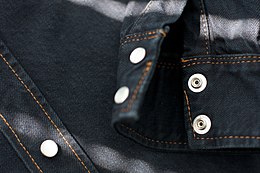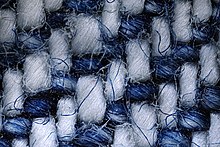Denim
 From Wikipedia - Reading time: 13 min
From Wikipedia - Reading time: 13 min


Denim is a sturdy cotton warp-faced[1] textile in which the weft passes under two or more warp threads. This twill weave produces a diagonal ribbing that distinguishes it from cotton duck. Denim, as it is recognized today, was first produced in Nîmes, France.[2]
Denim is available in a range of colors, but the most common denim is indigo denim in which the warp thread is dyed while the weft thread is left white. As a result of the warp-faced twill weaving, one side of the textile is dominated by the blue warp threads, and the other side is dominated by the white weft threads. Jeans fabricated from this cloth are thus predominantly white on the inside.[3] Denim is used to create a wide variety of garments, accessories, and furniture.
Etymology
[edit]Denim originated as a contraction of the French phrase serge de Nîmes ('serge from Nîmes').[4][3]
History
[edit]The examples and perspective in this section deal primarily with US and do not represent a worldwide view of the subject. (January 2024) |
Denim has been used in the United States since the mid-19th century.[5] Denim initially gained popularity in 1873 when Jacob W. Davis, a tailor from Nevada, manufactured the first pair of rivet-reinforced denim pants. The popularity of denim jeans outstripped the capacity of Davis's small shop, so he moved his production to the facilities of dry goods wholesaler Levi Strauss & Co., which had been supplying Davis with bolts of denim fabric.[6]
Throughout the 20th century, denim was used for durable uniforms like those issued to staff of the French national railways.[7][better source needed] In the post-war years, the Royal Air Force issued olive-drab denim coveralls (colloquially known as "denims") for dirty work.[8]
This section needs expansion with: a paragraph discussing the rise of denim's popularity during the 1950s and '60s. You can help by adding to it. (May 2023) |

By the 1970s, denim jeans were such an integral part of youth culture[9] that automobile manufactures, beginning with American Motors Corporation began offering denim-like interior finishes.[10][11] (Because denim cannot pass fire resistance safety standards,[12] indigo-colored spun nylon or vinyl was used,[13] with contrast-stitching and copper rivets helping to sell the effect.) A Levi's-branded trim package debuted with AMC's 1973 model year. Similar packages were available from Volkswagen from 1973 to 1975 (the "Jeans Beetle")[14][15] and from Jeep from 1975 through 1977.[16]
Creating denim
[edit]All denim is created through generally the same process:[17]
- Cotton fiber is spun into yarn
- The warp yarn is dyed, while the weft is left white (usually)
- The yarns are woven on a shuttle loom or projectile loom
- The woven product is sanforized
Yarn production
[edit]Traditional denim yarn is composed entirely of cotton. Once cotton fibers are cleaned and combed into long, cohesive lengths of similar-length fiber, they are spun into yarn using an industrial machine. Throughout the creation of denim, washes, dyes, or treatments are used to change the appearance of denim products.
Some yarns may substitute an elastic component such as spandex for up to 3% of the cotton, the woven form of which (typically called 'stretch denim') may have a elasticity of up to 15%.
Dyeing
[edit]Denim was originally dyed with indigo dye extracted from plants, often from the genus Indigofera. In South Asia, indigo dye was extracted from the dried and fermented leaves of Indigofera tinctoria; this is the plant that is now known as "true indigo" or "natural indigo". In Europe, the use of Isatis tinctoria, or woad, can be traced back to the 8th century BC, although it was eventually replaced by Indigofera tinctoria as the superior dye product. However, most denim today is dyed with synthetic indigo dye. In all cases, the yarn undergoes a repeated sequence of dipping and oxidation—the more dips, the stronger the color of the indigo.[18]
Before 1915, cotton yarns were dyed using a skein dyeing process, in which individual skeins of yarn were dipped into dye baths. Rope dyeing machines were developed in 1915, and slasher or sheet dyeing machines were developed in the 1970s. These methods involve a series of rollers that feed continuous yarns in and out of dye vats. In rope dyeing, continuous yarns are gathered together into long ropes or groups of yarns – after these bundles are dyed, they must be re-beamed for weaving. In sheet dyeing, parallel yarns are laid out as a sheet in the same order in which they will be woven; because of this, uneven dye circulation in the bath can lead to side-to-side color variations in the woven cloth. Rope dyeing eliminates this possibility because color variations can be evenly distributed across the warp during beaming.[18][19]
Denim fabric dyeing is divided into two categories: indigo dyeing (Indigo dye is a unique shade of blue) and sulfur dyeing (Sulfur dye is a synthetic organic dye and it is formed by sulphurisation of organic intermediates, this contains nitro or amino groups). Indigo dyeing produces the traditional blue color or shades similar to it. Sulfur dyeing produces specialty black and other colors, such as red, pink, purple, grey, rust, mustard, and green.
Weaving
[edit]

Most denim made today is made on a shuttleless loom[20] that produces bolts of fabric 60 inches (1,500 mm) or wider, but some denim is still woven on the traditional shuttle loom, which typically produces a bolt 30 inches (760 mm) wide. Shuttle-loom-woven denim is usually recognizable by its selvedge (or selvage), the edge of a fabric created as a continuous cross-yarn (the weft) reverses direction at the edge side of the shuttle loom. The selvedge is traditionally accentuated with warp threads of one or more contrasting colors, which can serve as an identifying mark.
Although quality denim can be made on either loom, selvedge denim has come to be associated with premium products since final production that showcases the selvedge requires greater care of assemblage.[21]
The thickness of denim can vary greatly, with a yard of fabric weighing anywhere from 9 to 32 oz (260 to 910 g), with 11 to 14 oz (310 to 400 g) being typical.[22]
Uses
[edit]
Denim is frequently used for a wide array of consumer products, including:
- Clothing
- Accessories
- Furniture
Art
[edit]Denim has been a medium for many artists. At least one artist, Ian Berry, uses old or recycled denim, exclusively in crafting his portraits and other scenes.[23]
Worldwide market
[edit]
In 2020, the worldwide denim market equaled US$57.3 billion, with demand growing by 5.8% and supply growing by 8% annually.[24] Over 50% of denim is produced in Asia, most of it in China, India, Turkey, Pakistan, and Bangladesh.[citation needed]
Globally, the denim industry is expected to grow at a CAGR of over 4.8% from 2022 to 2026, with the market value expected to increase from $57.3 billion to $76.1 billion.[25]
See also
[edit]References
[edit]- ^ Mogahzy, Y. E. (2009). Engineering Textiles: Integrating the Design and Manufacture of Textile Products (First ed.). Woodhead Publishing. p. 362. ISBN 978-1-84569-048-9.
- ^ "Story of Denim Blue Jeans across the Eras" (PDF). Archived from the original (PDF) on 21 April 2018. Retrieved 21 April 2018.
- ^ a b St. Clair, Kassia (2018). The Golden Thread: How Fabric Changed History. London: John Murray. p. 177. ISBN 978-1-4736-5903-2. OCLC 1057250632.
- ^ Bellis, Mary (19 May 2014). "Levi Strauss - The History of Blue Jeans". About.com. Archived from the original on 1 January 2013. Retrieved 25 August 2015.
Levi Strauss had the canvas made into waist overalls. Miners liked the pants, but complained that they tended to chafe. Levi Strauss substituted a twilled cotton cloth from France called "sergé de Nimes". The fabric later became known as denim and the pants were nicknamed blue jeans.
- ^ Hegarty, Stephanie (28 February 2012). "How jeans conquered the world". BBC News. Retrieved 25 August 2015.
- ^ Salazar, James B. (1 June 2010). "Fashioning the historical body: the political economy of denim". Social Semiotics. 20 (3): 293–308. doi:10.1080/10350331003722851. ISSN 1035-0330. S2CID 144304564.
- ^ Uniforms. static.cnews.fr. Retrieved 9 September 2023.
- ^ Bagshaw, R.; Deacon, R.; Pollock, A.; Thomas, M. (2006). RAF Little Rissington: the Central Flying School 1946-76. Pen and Sword Books. ISBN 9781844153817.
- ^ Strohl, Daniel (30 June 2007). "American Flava: the Levi's Gremlin press release". Hemmings. Retrieved 30 September 2019.
- ^ "Even AMC cars were hit by the blue jeans craze of the 1970s". MeTV. 16 August 2017. Retrieved 30 September 2019.
- ^ "1973 AMC Full Line brochure". oldcarbrochures.org. pp. 6–8.
- ^ Stopford, William (27 September 2015). "Top 10 Obscure Special Editions and Forgotten Limited-Run Models: AMC Edition". Curb side classic. Retrieved 30 September 2019.
- ^ Statham, Steve (2002). Jeep Color History. MBI Publishing. pp. 101–102. ISBN 9780760306369. Retrieved 30 September 2019.
AMC offered an optional Levis package in 1975 CJ denim-like vinyl and matching canvas top.
- ^ Torchinsky, Jason (20 May 2013). "A Pantload Of Jeans-Themed Cars On The Anniversary Of Levi's Patent". Jalopnik. Retrieved 30 September 2019.
- ^ "Chronology and Descriptions". Jeansbeetles.com. Retrieved 21 August 2015.
- ^ "1977 Jeep Full Line brochure". oldcarbrochures.org. p. 28. Retrieved 30 September 2019.
- ^ Chauncy, Barbara (2011). Denim by design. Krause Publications Craft. ISBN 9780896895980.
- ^ a b Bojer, Thomas Stege (16 December 2016). "How Denim Is Made: Indigo Dyeing". Denimhunters. Archived from the original on 3 September 2019. Retrieved 2 September 2019.
- ^ Mercer, Harry (19 May 2011). "Rope Dyeing Vs Slasher (Sheet) Dyeing". Denims and Jeans. Archived from the original on 12 October 2016. Retrieved 2 September 2019 – via Archive.org.
- ^ K W Yeung, Yan Li, L Yao (2003). The China and Hong Kong Denim Industry. p. 11.
{{cite book}}: CS1 maint: multiple names: authors list (link) - ^ Cadigan, Erin (13 February 2014). Sourcing and Selecting Textiles for Fashion: Sourcing and Selection. A&C Black. p. 55. ISBN 978-2-940496-10-5.
- ^ Rubin, Ellen (24 April 2022). "The Denim Weight of Jeans". Unsustainable. Retrieved 28 May 2023.
- ^ "Artist creates works in denim". BBC News. 23 May 2018. Retrieved 29 June 2018.
- ^ "Global Denim Jeans Market Report 2022: Market to Reach US$76.1 Billion by 2026 - U.S. Market is Estimated at $15.1 Billion in 2021, While China is Forecast to Reach $15.5 Billion by 2026". GlobeNewswire (Press release). 8 February 2022. Retrieved 22 March 2022.
- ^ "By 2026, the denim market expected value will be $ 79.1 billion". Techno Fashion World. 5 January 2022. Retrieved 22 March 2022.
 KSF
KSF